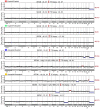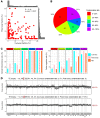DNA methylome reveals cellular origin of cell-free DNA in spent medium of human preimplantation embryos
- PMID: 34128477
- PMCID: PMC8203451
- DOI: 10.1172/JCI146051
DNA methylome reveals cellular origin of cell-free DNA in spent medium of human preimplantation embryos
Abstract
The discovery of embryonic cell-free DNA (cfDNA) in spent embryo culture media (SECM) has brought hope for noninvasive preimplantation genetic testing. However, the cellular origins of SECM cfDNA are not sufficiently understood, and methods for determining maternal DNA contamination are limited. Here, we performed whole-genome DNA methylation sequencing for SECM cfDNA. Our results demonstrated that SECM cfDNA was derived from blastocysts, cumulus cells, and polar bodies. We identified the cumulus-specific differentially methylated regions (DMRs) and oocyte/polar body-specific DMRs, and established an algorithm for deducing the cumulus, polar body, and net maternal DNA contamination ratios in SECM. We showed that DNA methylation sequencing accurately detected chromosome aneuploidy in SECM and distinguished SECM samples with low and high false negative rates and gender discordance rates, after integrating the origin analysis. Our work provides insights into the characterization of embryonic DNA in SECM and provides a perspective for noninvasive preimplantation genetic testing in reproductive medicine.
Keywords: Embryonic development; Epigenetics; Genetics; Molecular diagnosis; Reproductive Biology.
Conflict of interest statement
Figures






Similar articles
-
A computational DNA methylation method to remove contaminated DNA from spent embryo culture medium for noninvasive preimplantation genetic testing.EBioMedicine. 2025 Apr;114:105669. doi: 10.1016/j.ebiom.2025.105669. Epub 2025 Mar 29. EBioMedicine. 2025. PMID: 40158389 Free PMC article.
-
Multicenter prospective study of concordance between embryonic cell-free DNA and trophectoderm biopsies from 1301 human blastocysts.Am J Obstet Gynecol. 2020 Nov;223(5):751.e1-751.e13. doi: 10.1016/j.ajog.2020.04.035. Epub 2020 May 26. Am J Obstet Gynecol. 2020. PMID: 32470458
-
Non-invasive pre-implantation genetic testing's reliability for aneuploidy using Cell-free DNA in embryo culture media.J Gynecol Obstet Hum Reprod. 2024 Oct;53(8):102808. doi: 10.1016/j.jogoh.2024.102808. Epub 2024 May 31. J Gynecol Obstet Hum Reprod. 2024. PMID: 38825167
-
The origin and possible mechanism of embryonic cell-free DNA release in spent embryo culture media: a review.J Assist Reprod Genet. 2023 Jun;40(6):1231-1242. doi: 10.1007/s10815-023-02813-z. Epub 2023 May 2. J Assist Reprod Genet. 2023. PMID: 37129724 Free PMC article. Review.
-
Non-invasive preimplantation genetic testing for aneuploidies: an update.Reprod Biomed Online. 2022 May;44(5):817-828. doi: 10.1016/j.rbmo.2022.01.012. Epub 2022 Jan 31. Reprod Biomed Online. 2022. PMID: 35307298 Review.
Cited by
-
An Update on Non-invasive Approaches for Genetic Testing of the Preimplantation Embryo.Curr Genomics. 2022 Nov 18;23(5):337-352. doi: 10.2174/1389202923666220927111158. Curr Genomics. 2022. PMID: 36778192 Free PMC article. Review.
-
Optimizing non-invasive preimplantation genetic testing: investigating culture conditions, sample collection, and IVF treatment for improved non-invasive PGT-A results.J Assist Reprod Genet. 2024 Feb;41(2):465-472. doi: 10.1007/s10815-023-03015-3. Epub 2024 Jan 6. J Assist Reprod Genet. 2024. PMID: 38183536 Free PMC article.
-
Clinical-grade whole genome sequencing-based haplarithmisis enables all forms of preimplantation genetic testing.Nat Commun. 2024 Sep 2;15(1):7164. doi: 10.1038/s41467-024-51508-1. Nat Commun. 2024. PMID: 39223156 Free PMC article.
-
Non-Invasive Preimplantation Genetic Testing.Genes (Basel). 2025 Apr 30;16(5):552. doi: 10.3390/genes16050552. Genes (Basel). 2025. PMID: 40428374 Free PMC article. Review.
-
Non-Invasive Preimplantation Genetic Testing for Aneuploidy and the Mystery of Genetic Material: A Review Article.Int J Mol Sci. 2022 Mar 25;23(7):3568. doi: 10.3390/ijms23073568. Int J Mol Sci. 2022. PMID: 35408927 Free PMC article. Review.
References
Publication types
MeSH terms
Substances
LinkOut - more resources
Full Text Sources
Other Literature Sources

